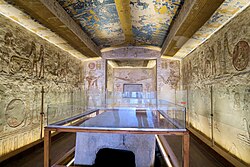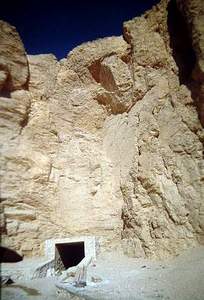
Tomb KV6 in Egypt's Valley of the Kings is the final resting place of the 20th-Dynasty Pharaoh Ramesses IX. However, the archaeological evidence and the quality of decoration it contains indicates that the tomb was not finished in time for Ramesses's death but was hastily rushed through to completion, many corners being cut, following his demise.

Usermaatre Setepenre Meryamun Ramesses VII was the sixth pharaoh of the 20th Dynasty of Ancient Egypt. He reigned from about 1136 to 1129 BC and was the son of Ramesses VI. Other dates for his reign are 1138–1131 BC. The Turin Accounting Papyrus 1907+1908 is dated to Year 7 III Shemu day 26 of his reign and has been reconstructed to show that 11 full years passed from Year 5 of Ramesses VI to Year 7 of his reign.

Tomb WV23, also known as KV23, is located in the Western Valley of the Kings near modern-day Luxor, and was the tomb of Pharaoh Ay of the Eighteenth Dynasty. The tomb was discovered by Giovanni Battista Belzoni in the winter of 1816. Its architecture is similar to that of the tomb of Akhenaten, with a straight descending corridor leading to a "well chamber" that has no shaft. This leads to the burial chamber, which now contains the reconstructed sarcophagus, which had been smashed in antiquity. The tomb had also been anciently desecrated, with many instances of Ay's image or name erased from the wall paintings. Its decoration is similar in content and colour to that of the tomb of Tutankhamun (KV62), with a few differences. On the eastern wall there is a depiction of a fishing and fowling scene, which is not shown in other royal tombs, normally appearing in burials of nobility.

Tomb KV43 is the tomb of Pharaoh Thutmose IV in the Valley of the Kings in Luxor, Egypt. It has a dog-leg shape, typical of the layout of early 18th Dynasty tombs. KV43 was rediscovered in 1903 by Howard Carter, excavating on behalf of Theodore M. Davis.

Tomb KV9 in Egypt's Valley of the Kings was originally constructed by Pharaoh Ramesses V. He was interred here, but his uncle, Ramesses VI, later reused the tomb as his own. The architectural layout is typical of the 20th Dynasty – the Ramesside period – and is much simpler than that of Ramesses III's tomb (KV11). The workmen accidentally broke into KV12 as they dug one of the corridors. In 2020, the Egyptian Tourism Authority released a full 3D model of the tomb with detailed photography, available online.
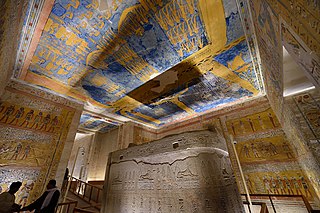
Tomb KV2, found in the Valley of the Kings, is the tomb of Ramesses IV, and is located low in the main valley, between KV7 and KV1. It has been open since antiquity and contains a large amount of graffiti.

Tomb KV11 is the tomb of Pharaoh Ramesses III. It is located in the main valley of the Valley of the Kings. The tomb was originally started by Setnakhte, but abandoned when it unintentionally broke into the earlier tomb of Amenmesse (KV10). Setnakhte was buried in KV14. The tomb KV11 was later restarted and extended and on a different axis for Ramesses III.

Tomb KV61 is an unused tomb in Egypt's Valley of the Kings. It was discovered by Harold Jones, excavating on behalf of Theodore M. Davis, in January 1910. The tomb consists of an irregularly-cut room at the bottom of a shaft. It was apparently unused and undecorated, thus its intended owner is unknown.

The area of the Valley of the Kings, in Luxor, Egypt, has been a major area of modern Egyptological exploration for the last two centuries. Before this, the area was a site for tourism in antiquity. This area illustrates the changes in the study of ancient Egypt, beginning as antiquity hunting and ending with the scientific excavation of the whole Theban Necropolis. Despite the exploration and investigation noted below, only eleven of the tombs have actually been completely recorded.

Tomb KV3, located in Egypt's Valley of the Kings, was intended for the burial of an unidentified son of Pharaoh Ramesses III during the early part of the Twentieth Dynasty. It is similar in design to the "straight axis" tombs typical of this dynasty, and an ostracon written in hieratic script from the time of Ramesses III mentions the founding of a tomb for a royal prince, likely this tomb. The unfinished state of a couple of rooms in the tomb along with scant archeological evidence suggests that the tomb was never used. Some have suggested that it was originally intended for use by the prince regent who would succeed as Ramesses IV, and who started building his own tomb (KV2) soon after he came to the throne.
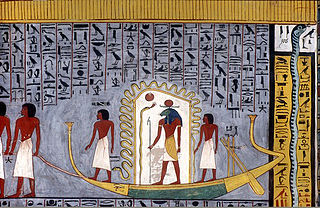
Tomb KV16 is located in the Valley of the Kings in Egypt. It was used for the burial of Pharaoh Ramesses I of the Nineteenth Dynasty. The burial place was discovered by Giovanni Belzoni in October 1817.

Tomb KV13, located in the Valley of the Kings in Egypt, was cut and decorated for the burial of the noble Bay of the Nineteenth Dynasty. An ostraca published in the French Egyptological journal BIFAO in 2000 records that Chancellor Bay was executed by pharaoh Siptah. Consequently, Bay was never buried in his tomb. Moreover, no funerary goods were found in the tomb belonging to Bay. It was later reused by two princes of the Twentieth Dynasty, Mentuherkhepsef, a son of Ramesses III, and his nephew, Amenherkhepshef, a son of Ramesses VI.

Tomb WV24 is an ancient Egyptian tomb located in the western arm of the Valley of the Kings. It was reported by Robert Hay and John Wilkinson in the 1820s and visited by Howard Carter; however, it was not fully explored until Otto Schaden's excavations in 1991.
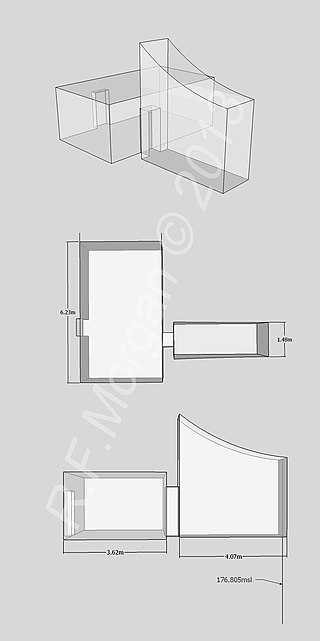
Tomb KV28 is an ancient Egyptian tomb located in the Valley of the Kings in the Theban Necropolis in Upper Egypt. It consists of a short shaft leading to a single rectangular chamber. It has been known since the 1830s as it is mentioned by John Gardiner Wilkinson. In 1889 Eugène Lefébure said it contained parts of mummies and their bandaging. The tomb was excavated in the 1990s by Donald P. Ryan who found the bones of three individuals, fragments of a limestone canopic jar, numerous wooden fragments, and early to mid Eighteenth Dynasty pottery. The occupants were possibly nobles, given the tomb's proximity to the tomb of Thutmose IV.

Tomb KV27 is located in the Valley of the Kings in Egypt. This tomb was visited by John Wilkinson, but was not fully explored until the 1990s, by Donald P. Ryan of Pacific Lutheran University. The tomb consists of four rooms and is undecorated; nothing is known about its occupant.

Tomb KV58, known as the "Chariot Tomb", is located in the Valley of the Kings in Egypt. It was discovered in January 1909 by Harold Jones, excavating on behalf of Theodore M. Davis. The circumstances of the discovery and specifics of the excavation were only given a passing mention in Davis' account, who attributes the discovery to Edward Ayrton in 1907 instead. The tomb consists of a shaft leading to a single chamber and contained only embossed gold foil, furniture knobs, and a single ushabti. The contents likely originated from the Eighteenth Dynasty tomb of Ay in WV23. Davis considered this tomb to be the burial place of the then little-known pharaoh Tutankhamun.

Tomb KV50 is located in the Valley of the Kings, in Egypt. It was discovered in 1906 by Edward R. Ayrton excavating on behalf of Theodore M. Davis. Together with KV51 and KV52, it forms a group known as the "Animal Tombs". It contained the burial of a dog mummy and a mummified monkey and is probably associated with the nearby tomb of Amenhotep II (KV35).
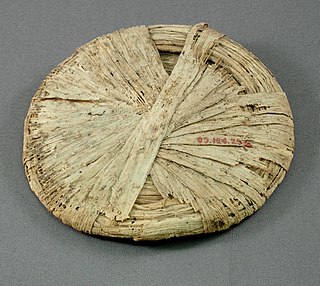
Tomb KV54 is located in the Valley of the Kings, in Egypt. It was originally excavated by Edward R. Ayrton on behalf of the American lawyer Theodore M. Davis, who funded the work.

Tomb KV53 is located in the Valley of the Kings, in Egypt. It was discovered in 1906 by Edward R. Ayrton excavating on behalf of Theodore M. Davis. It has been excavated but never been fully planned, and consists of a single chamber at the end of a shaft.

The Valley of the Kings, also known as the Valley of the Gates of the Kings, is an area in Egypt where, for a period of nearly 500 years from the Eighteenth Dynasty to the Twentieth Dynasty, rock-cut tombs were excavated for pharaohs and powerful nobles under the New Kingdom of ancient Egypt.
